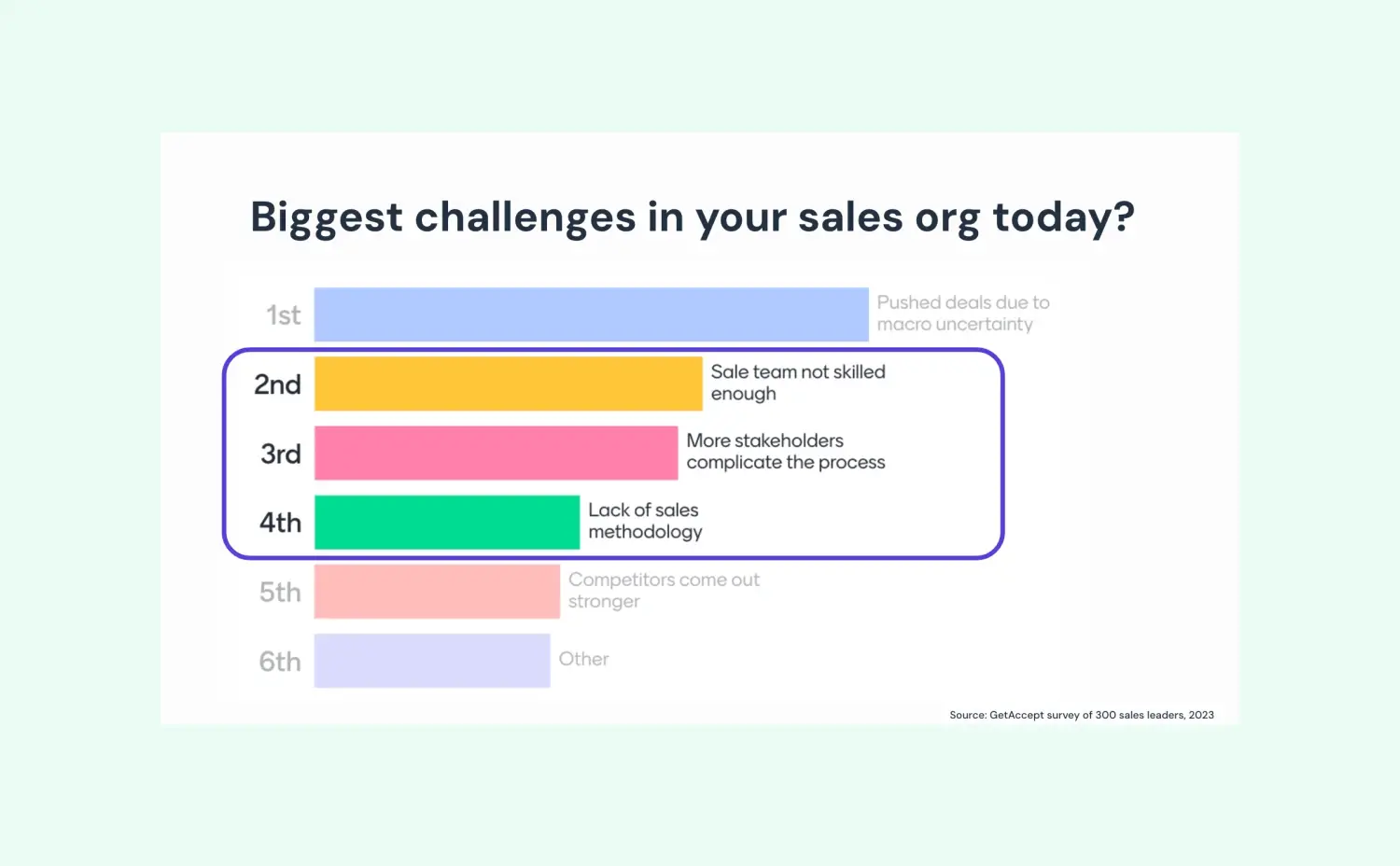Selling is getting harder, and nobody is denying it.
Only 17% of reps contribute to 81% of the quota. Fully aware of the challenge, we hosted four webinars in May, inviting internal and external thought leaders within product and sales to discuss how to tackle these challenges most effectively.
Here are five key takeaways that you can act on immediately.
Highlight 1: Your Sales Methodology is Not Flawed. It’s Just Not Being Followed.
Many who joined the webinar raised the question of how to find the “best” sales methodology or improve their current one. The thing is, your methodology is fine – you just need to make sure everyone in sales follows it properly.
Implementing and maintaining a sales methodology takes persistence and adaptability. The following three aspects are essential for long-term success:
- Gaining buy-in from key sales reps
- Continuous training and enablement to ensure the methodology remains relevant and effective
- Embedding your methodology into the CRM and sales process so it becomes a natural part of the sales team's daily routine
Highlight 2: Sellers Don’t Close Deals, Buyers Do.
Sellers play a role, but their influence is limited in B2B purchasing. Gartner research shows prospects spend only 17% of their time engaging with suppliers, translating to 5% per supplier. Sellers need to facilitate the buying process even when not present, and in this process, also shift their mindset from “closing” to “discovering and helping” buyers.- Track engagement and communicate directly through the platform.
- Identify and engage multiple stakeholders in a deal using tools like GetAccept.
- Pull stakeholders together for alignment and quick decision-making.
Mutual Action Plans (MAPs) are strategic tools that align the steps and responsibilities of both the buyer and seller toward a common goal. They are particularly useful in complex sales scenarios with multiple stakeholders and steps.
The key to effective MAPs is collaboration with the customer to create realistic timelines and actionable steps. Keeping these plans visible and front-and-center ensures accountability and progress toward the “go live” date.
Highlight 3: Ask the Right Questions to Uncover All Stakeholders
According to the EBSTA B2B sales benchmark report, involving approximately eight stakeholders will help you increase win rates and maximize time to close. Here are the stakeholders Tom Glason believes are the most critical to engage, along with questions you can ask to uncover them:
Champion: Critical for advocating and navigating the buying process internally.
Decision Maker (DM): Understand their criteria and what success looks like for them.
Questions to ask:- How would your manager usually get involved?
- Who will ultimately decide which solution is selected?
- When you’ve bought a solution like this in the past, what was the typical process you followed? What criteria did you use to make a decision?
- Will this be a committee decision or a single-person decision? Who else is on that committee?
Technical Buyer: Evaluate the technical aspects and feasibility of a tool.
Questions to ask:- Who else would this project be important to?
- Who else will want to ensure this project is successful?
Economic Buyer: Understand their process and budget allocation.
Questions to ask:- Who is typically the most senior person to get involved?
Financial Buyer: Understand their process and budget allocation.
Questions to ask:- Who is responsible for approving the budget for this purchase?
- Who handles the financial review and analysis for purchases like this?
- Can you walk me through your budget approval process?
Highlight 4: How to Enhance Your CRM Data for a More Accurate Pipeline Forecast
A common struggle many teams face is uncertainty about whether the CRM data truly reflects the sales process. If reps don’t update the stage, managers won’t have an accurate picture of the forecast. The result is inaccurate forecasting, inability to act proactively, and risking revenue growth.
To enhance your CRM data for a more accurate pipeline forecast, you can:
- Use merge tags to fill in data points.
- Leverage automations to sync and save recipient-filled data back to the CRM.
- Use Mutual Action Plans to track upcoming tasks, milestones, and deadlines.
- Compare Mutual Action Plan overviews to check if the completion rate matches the deal progress within your CRM.
- Auto-update deal stages when certain milestones are completed.
In summary, using a Mutual Action Plan and connecting it with your CRM is a powerful way to not only get your reps working out of the CRM more but also significantly enhance your existing CRM data.
Highlight 5: How to Select the Tech Tool that Supports Your Sales Team, Instead of Slowing Them Down
According to a survey conducted by Salesforce, 79% of sales reps say they have experienced frustration with their CRM system. A truly successful CRM integration understands the underlying challenges of working with a CRM and helps you overcome those challenges on top of its core product offering.
To do so, a tech tool should:
- Have a well-designed interface that allows users to accomplish tasks in a few clicks.
- Be well integrated with your CRM, so you don’t need to leave your CRM environment.
- Enable automation based on your CRM logic, ensuring flexibility and leveraging CRM data to keep users within the platform.
- Have a dedicated in-house tech team to ensure the integration supports your long-term growth as your company scales.
We’ll be back with more webinars sharing insights and best practices in sales in August. Which themes would you like to know more about?
Answer the poll and let us know what you think.
.webp)



